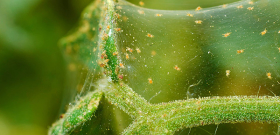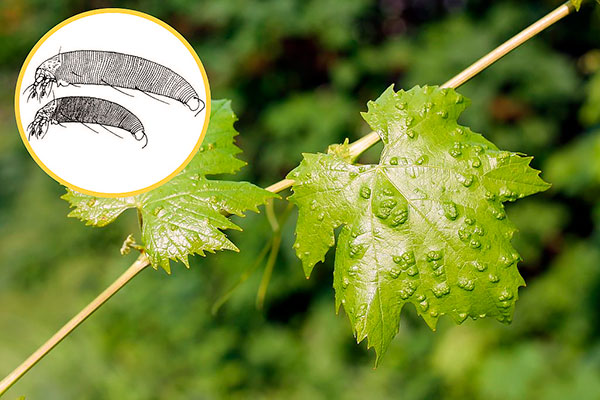
In Russia, Ukraine, Kazakhstan and Moldova, several dozen species of mites live on grapes. Almost always, they form stable acarocenoses here, which, in the absence of human action, in most cases turn out to be self-regulating and do not lead to severe damage to the vine. In such complexes, predatory mites and partially predatory insects effectively regulate the number of grape phytophagous mites, preventing the latter from multiplying in large numbers and causing economically significant harm.
Indeed, various harmful grape mites become dangerous in vineyards in which pesticide treatments are carried out with certain violations of biological balance. In these cases, it is the predators that suffer first of all, the number of which is always less than the number of phytophages. And, in fact, harmful grape mites after such treatments in the absence of natural enemies multiply intensively and can cause serious harm. It is in such situations that it is necessary to apply various methods of control that allow you to regulate the number of pests.
The most common and economically significant mites - pests of grapes are three types:
- Common spider mite;
- grape itch;
- Vine mite.
A significant danger is also represented by the grape flat tick, which is now actively penetrating into the Crimea.However, most of the regions of Russia and Ukraine with industrial vineyards do not have it.
All three types of mites are approximately equally harmful, but the spider mite is considered the most common and most dangerous pest of them. With a serious infection of the vineyard, it significantly reduces the yield, the bushes weaken, some of them may subsequently die under adverse weather conditions - a long absence of watering, severe frosts, icing.
And, despite some specifics in the biology of each of these species, it is necessary to deal with all mites on grapes with approximately the same methods. Moreover, it is imperative to fight in order to avoid large financial losses and the death of bushes. What do you need to know for this?
Grape itch and features of its biology
Grape itch (Eriophyes vitis), also known as a felt mite, belongs to four-legged mites and has an elongated body 0.14 mm long in males and 0.16 mm in females. To feed, these mites pierce the skin of the leaf above the vein and suck the juice, while injecting saliva into the vein. The leaf reacts to this saliva by forming at first a whitish, and later a reddish felt coating. For this raid, the pest got its name.
On a note
Outwardly, this "felt" is similar to the fluff characteristic of mildew, but it is easily distinguished by the fact that it is difficult to erase it from the sheet. Plaque with mildew is easily erased with a finger.
In spring and early summer, when there are few mites on the grapes, they are on the underside of the leaf plate. It is here that accumulations of felt plaque appear, and in these places a depression appears on the sheet. Directly above it, characteristic gall-like swellings appear on the upper surface of the leaf.
The photo below shows such a felt coating on the underside of the sheet:
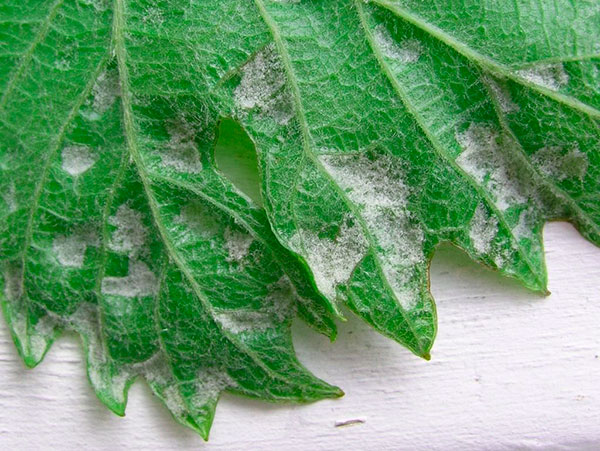
And here - galls, or erineums on the upper surface:
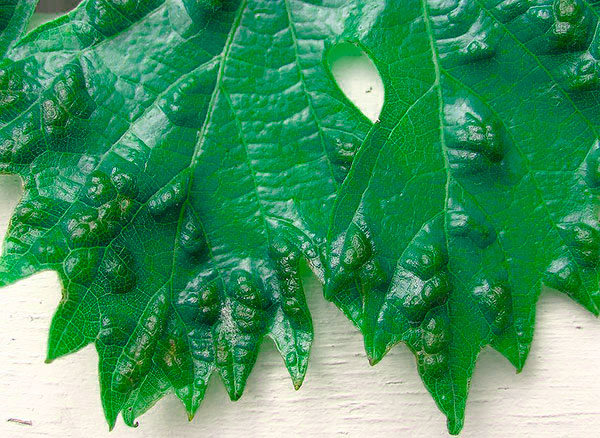
As the number of mites on the bush increases, the felt coating on the lower surface of the leaf becomes continuous, and on top the leaf is literally dotted with cones. All this set of signs is called erinosis (according to the Latin name for grape itch) and is considered an independent disease of grapes. It is by them that the tick itself can be identified, since visually, with its tiny size, it is impossible to examine it or distinguish it from a grapevine tick.
At this stage of infection, when the entire underside of the leaf plate is covered with “felt”, the itch itself moves to the upper side and settles here along the veins. The leaves at this time become completely ugly, many of them dry out and crumble.
As a rule, with the rapid growth of an adult bush, itching in one season affects only the lower leaves, but in some advanced cases, the second or third generation of pests spreads to all leaves, and in July-August, growing shoots and even clusters can be affected. The latter, when felt appears on them, are unsuitable either for eating or for making wine.
The itch itself is interesting in that, unlike most other mites, it has only two pairs of legs (other mites have four) and an elongated body. Only fertilized females overwinter with him in cracks in the bark, under the scales of fruit buds. In the spring, in April-May, they begin to feed and lay eggs. During the season in the conditions of the Crimea, the south of Ukraine and Moldova, 4-7 generations develop.
It is interesting
Previously, grape itch was considered the larvae of flies or the first stage of development of the spider mite.Only later studies showed that this is an independent species, the individuals of which at different stages of development look quite similar to each other. Moreover, in those days when the itch was considered a fly larva, it was also believed that the galls themselves on the leaves were the consequences of leaf damage by a fungal infection, and the flies were already laying their eggs in these galls.
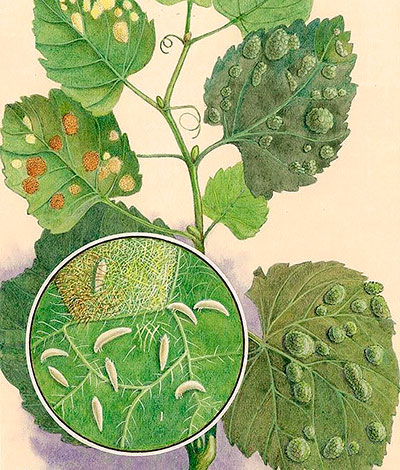
Previously, the itch was considered a fly larva, since outwardly they are very similar: an elongated body and 2 pairs of legs.
Within its vast world range, the grape itch forms several physiological races that differ so much in biology that they are sometimes considered different species.
For example, in Australia, Israel and the USA, populations of grape itch are known that do not affect the leaves, but spend their whole lives in the buds, preventing them from blooming and feeding on the juices that enter them. Another race, described in the USA and Hungary, does not form galls and tomentum at all, but leads to the folding of the leaves into a tube.
Nevertheless, in the south of Russia, in Ukraine and Moldova, the felt mite manifests itself precisely by the appearance of a felt coating and convex galls on the leaves. Bushes oppressed by pests give less yield and are less resistant to adverse environmental factors.
Vine mite
In terms of body shape and size, this parasite is very similar to the grape itch: it also has only four legs, it is elongated, and the size of an adult does not exceed 0.15 mm. When viewed under a microscope, each individual has a prominent and slightly wider anterior part of the body.
The grapevine mite (Phyllocoptes vitis) causes the so-called acarinosis, or curling of grape leaves.Its females, leaving winter shelters, begin to suck juices from grape leaves, and their saliva destroys chlorophyll and white dots appear on the leaves at the bite sites, translucent when the leaf is viewed in the light. When there are too many such skin punctures, the leaves begin to curl, deform and curl. Shoots with leaves affected in spring practically do not grow, new leaves do not form on them, and later they do not bear fruit.
From the lesions caused by grape pruritus, acarinosis differs in leaf curl and the absence of a felt coating. The photo below shows what the leaves of a plant affected by this pest look like:
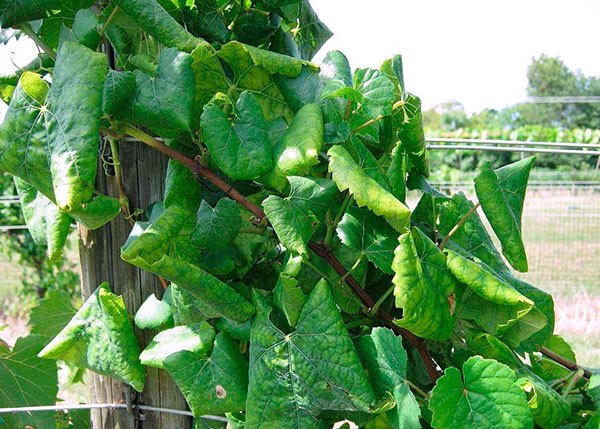
In the conditions of Moldova, this tick can give 3-4 generations per year, in the Crimea and France in very warm years, the number of generations reaches 10.
Interestingly, females of different generations in this species look different. In summer generations that do not survive into winter, females are honey or brownish in color and have tiny ivory growths all over their bodies. In wintering individuals, such growths are absent, and the body color is yellow-brown.
Grapevine mites leave for wintering in September-October, shortly before the leaves fall from the vine bushes. They hibernate, as a rule, under the scales of the buds, less often in cracks in the bark, especially in places where the old shoot passes to the growth of the current year.
Due to the weakening of the growth of shoots, especially after planned pruning, the bushes affected by the grape mite bear very little fruit. With a significant infection of the vineyard, the entire economy can become unprofitable.
Common spider mite
The common spider mite (Tetranychus urticae) is the most numerous and widespread pest of grapes. In all vineyards, its share among other phytophagous mites exceeds the numbers of any other species.
This mite feeds by sucking the juices from the leaf veins. At the puncture sites, translucent dots remain, which, when accumulated next to each other, merge into brown spots, in the center of which ruptures of the leaf plate appear. With a serious infection, the bush weakens, some of the fruits do not ripen on it, in frosty winters or dry summers, the most weakened plants may die.
Spider mites differ from previous species of grape mites in larger sizes (up to 0.4 mm), the presence of 8 legs, and the fact that females produce a small amount of cobwebs throughout their lives. When there are too many individuals on the leaves, this web entangles literally all the leaves and shoots, becoming a characteristic diagnostic feature.
In spider mites, only females hibernate, usually in the soil and under a layer of turf. In spring, they climb plants, begin to feed and lay eggs. At the same time, ticks of summer generations, dying before the onset of autumn, are yellowish or yellow-green, and wintering females are red, due to which their clusters are clearly visible on branches and trunks.
For example, below is a photo of a cluster of female spider mites:

The particular danger of the spider mite lies in its amazing omnivorousness: it can infect grassy weeds and garden plants, most bushes and trees. For this reason, its reservoir in the vineyard can be both the vine bushes themselves, and nearby trees or weeds growing in the aisles.
In addition, due to the mass character and frequent encounters with pesticide preparations, spider mites can develop resistance to individual acaricidal substances, which makes it very difficult to control them. Processing grapes with products that are usually considered effective, in some cases does not give the desired result.
A short interim summary: all grape phytophagous mites are very dangerous and can lead to both a decrease in yield and the death of individual bushes. It is not difficult to distinguish between infestations by these pests: grape pruritus provokes the appearance of a felt-like plaque on the underside of the leaves, the grapevine mite causes curliness, and when a spider mite is affected, the leaves become first speckled and then acquire a marble color.
On grapes in the conditions of the south of Russia, Ukraine and Moldova, other phytophagous mites can also harm, but their economic and economic importance is small. At the same time, the control measures for all these species are approximately the same.
Methods for dealing with ticks on grapes
Methods for combating mites on grapes are aimed either at destroying them with significant reproduction, or at keeping their numbers below the economic threshold of harmfulness. Within these limits, they do not cause economic damage and do not lead to the death of bushes. For different types of ticks, this threshold is:
- For grape itch - 5 ticks per 1 leaf of the plant in May-June;
- For grapevine mite - 3-4 individuals per 1 leaf of the plant in May, 6-7 individuals in June;
- For spider mites - 5-6 copies per 1 leaf in May-June, 8-10 copies per 1 leaf in July-October.

Spider mite: 1 - female, 2 - lower body of the female, 3 - male, 4 - larva, 5 - egg on the leaf, 6 - damaged leaf.
Moreover, it is believed that the presence of phytophagous mites in quantities below the economic threshold of harmfulness is even beneficial, since they support populations of predatory mites and insects, which help to keep the number of other pests, such as aphids, thrips, leafhoppers, and others, at a low level.
In other words, ideally, the farm should support an invertebrate community in which the number of herbivorous pests is kept within the necessary limits by populations of predatory insects.
However, practice shows that in most farms it is impossible to achieve such a balance due to the intensive pesticide press: plants are treated with pesticides at least once a year and most predators die here. But they cannot restore the population at such a speed as phytophages do.
As a result, in most vineyards, plants need to be treated at least once a year with effective acaricides. Timely carried out, such processing allows to destroy the main number of pests, and those that penetrate the vineyard again or survive during processing, until the end of the season do not have time to multiply in quantities exceeding the economic threshold of harmfulness.
In the fight against spider mites, it may be necessary to spray the grapes 1-2 more times per season if the pest multiplies very quickly, or if the drug chosen for the first treatment was ineffective.
In addition, and in some cases as an alternative to spraying with acaricides, other methods for the destruction of mites on grapes are also used:
- Biological control - the use of predatory insects and mites, the main food object of which are phytophagous mites;

The biological method of combating ticks involves the use of predatory mites, such as phytoseiulus.
- Pruning and destruction of affected leaves and shoots, complete cleaning of leaves in the fall after shedding;
- Autumn digging between rows to freeze wintering females of spider mites;
- Weed control, on which the first generations of tetranychids can develop.
Normally, agricultural measures and biological control are sufficient to keep the number of phytophagous mites within acceptable limits. However, in most farms, these measures begin to be observed after an episode of mass reproduction of pests, when pesticides are used to combat them, destroying useful arthropods at the same time. As a result, the biological balance is disturbed and a vicious circle of spraying plants with pesticides is launched. As a result, the use of acaricides is the norm almost everywhere, and the rest of the methods, if they are used, then as additional measures.
Means for the destruction of pests
All three types of grape mites (as well as predatory mites and other insects) are equally sensitive to most insecticides used for spraying vineyards. Traditionally, in large farms, relatively inexpensive, but effective drugs are used to combat these pests:
- Aktar;
- Acartan;
- Metaphos;
- Antio;
- Omite;
- Demitan;
- Envidor;
- Nissoran;
- Orthus;
- Zolon;
- Karbofos;
- Methyl parathion;
- Phosphamide;
- Vofatoks;
- Etaphos;
- Kleshchevit;
- colloidal sulfur;
- Bi-58;
- Tedion and others.
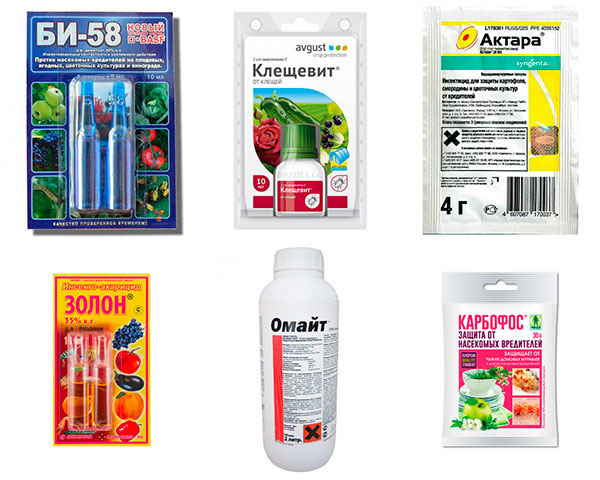
One of the most popular drugs for the fight against grape mites.
As a rule, the first spraying is carried out after the leaves bloom, but before the plants bloom. In each particular region, in the optimal case, it is necessary to calculate the period when wintering females begin to leave their wintering grounds, but do not yet have time to lay a large number of eggs. Destroying them at this time is most effective and ensures that ticks do not appear in large numbers on the bushes until the end of summer.
The most preferred for treatment at any time are drugs based on neonicotinoids (for example, Aktara). They have a pronounced systemic effect, that is, they penetrate into the tissues of plants, into the juices in the leaves, and poison only those mites that suck these juices. Predatory mites suffer from the action of such drugs to a much lesser extent and only when the drug enters directly on the integument of their bodies.
The most accessible and commonly used acaricides today are preparations based on organophosphorus compounds - karbofos, temefos, metaphos, dimethoate - however, due to the frequent use, some populations of ticks develop resistance to them. For the prevention of such resistance, as well as for the destruction of ticks on which these drugs have no longer worked, agents based on avermectins (for example, Kleshchevit), pyrethroids (Ivenhoe, Atrix), neonicotinoids (Calypso, Proteus) and propargite (Omayt) are used. The latter is considered the most preferred acaricide: to date, not a single case of tick resistance to it is known.
At home, in household plots, they often try to get rid of ticks with folk remedies: ammonia, a solution of soda, decoctions of onion or garlic husks, mixtures of vinegar, alcohol and other substances prepared according to special recipes. Such funds are good for their availability and relative safety for humans, but most of them are less effective than specialized acaricides. And some are completely useless for the destruction of ticks and protection against them.
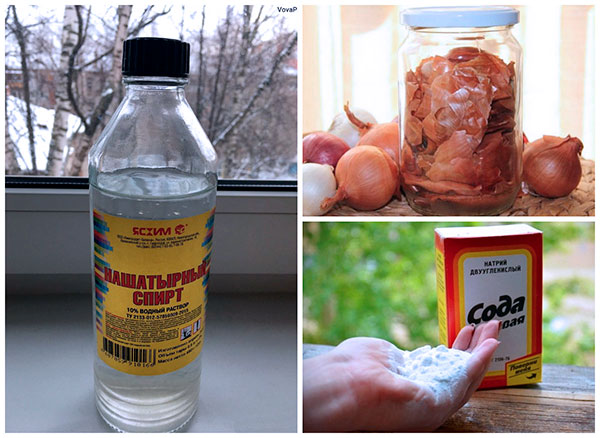
Folk remedies for the fight against grape mites.
Be that as it may, grapes cannot be constantly treated with the same agent. The preparations must be alternated so that the subsequent treatment is carried out with a substance with a substance of a different chemical class than that used in the previous spraying of the plant.
After the first spring treatment, even before flowering, all bushes must be regularly inspected and the affected leaves identified. If the number of mites and damaged leaves exceeds the limit of the economic threshold of damage, it is necessary to spray the grapes again. In especially dry years, when the spider mite multiplies on the plants, it is sometimes necessary to spray the vineyard 2-3 times per season.
Biological control methods
The biological control of grape mites consists in the settlement of the vineyard with predators that specialize specifically in feeding on mites. These include:
- Ticks fitoseyulyusy, neoseiyulyusy, amblyseyuyusy;
- Orius bugs and macrolophus;
- Ladybug stetorus point;
- Tick-eating thrips;
- Some gall midges;
- Staphylinid beetles;
- lacewings;

The lacewing is a small predatory insect. Helps in the fight against grape mites.
- Several types of pronematid mites that do not attack adult mites, but actively eat their eggs.
Of these, phytoseiulus mites are bred and sold in special nurseries, including in retail lots - specialized predators, the main food object for which is precisely spider and grape mites, and at all stages of development - and eggs, and nymphs, and adults. In the absence of phytophagous mites, they can eat small herbivorous thrips, other insects, in exceptional cases even the pollen of some flowers, but where herbivorous mites completely disappear, phytoseiulus gradually die off.
At the same time, with a strong infestation of grapes with tetranychids, phytoseiulus multiply very quickly and destroy most of the pests.
Practice shows that if, in addition to grape mites, there are no more pests on the farm, the purchase and resettlement of phytoseiulus and other predators in the area is the best step both from a biological and economic point of view.
For example, 250 macrolophus bugs cost 3,500 rubles and protect an area of 0.1 ha from ticks, and 10,000 amblyseus mites cost 3,000 rubles and protect a 0.5 ha area (to cure an infected plant, it is enough to evict 100- 150 individuals, that is, a package of 3,000 rubles is enough to treat and protect 60-100 bushes). At the same time, in infected vineyards, these predators breed throughout the warm season until they destroy the entire population of pests.They are completely harmless to people, pets and beneficial insects on the site, and when grape mites and other food objects (that is, pests) disappear here, predators gradually die off.
Prevention of the appearance of pests on grapes
The best protection of a vineyard against mass reproduction of phytophagous mites is to maintain in them a stable complex of native insects, spiders and mites, among which there are a large number of predators that can effectively control the number of pests.
By and large, in vineyards it is useful to maintain a constant presence of a small number of spider mites and itchs, which will serve as food for a stable population of predators.
For prevention, it is useful once a year in the spring to release a portion of predatory mites or bedbugs into the vineyard, which will prevent the reproduction of pests, and will also be able to reduce the number of those phytophages that are already actively breeding here. Ideally, near the vineyard there should be a forest belt or a mixed garden with fruit and ornamental trees, including peaches, apple trees, nuts. Predatory insects and mites will constantly breed here, which then can easily migrate to the vineyard and regulate the number of pests here.

The perfect combination of vineyard location and forest belt to prevent the spread of mites.
In the garden, low-growing fruit trees - apples, peaches, pears - are also useful to plant near the vineyard to provide a variety of landscape for predators.
In autumn, as a preventive measure, fallen leaves should be collected and burned, and the aisles in the vineyard should be dug up so that the individuals that have left for the winter freeze out when the temperature drops. Sick and severely affected shoots should preferably be cut and burned.
Finally, it is quite effective to grow grape varieties that are resistant to grape itch and vine mites. For example, mites affect to a lesser extent hard-leaved and pubescent grape varieties such as Riesling, Lanyan, Sauvignon. Finally, itching practically does not affect American grape varieties, and in the United States itself it harms mainly on French and Italian varieties.

